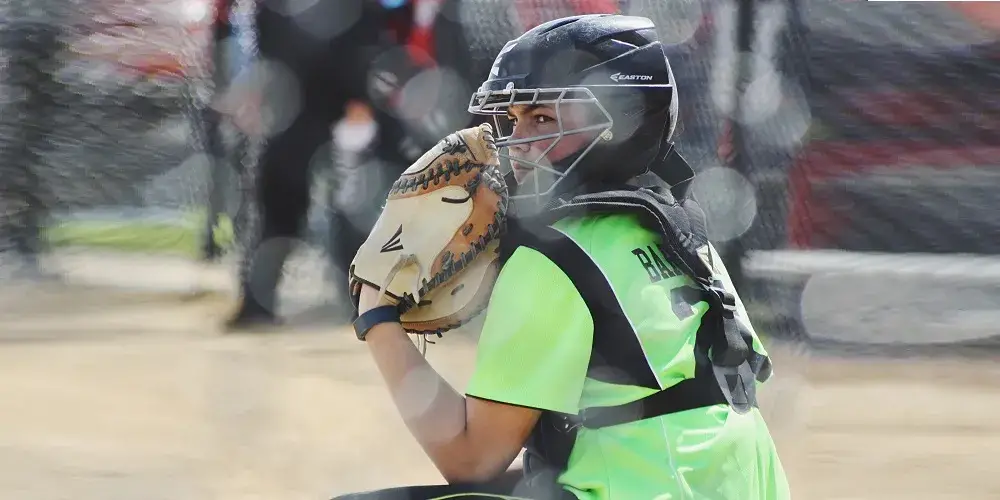
The softball catcher ready position will determine the effectiveness of the catcher once the ball leaves the pitchers hand. The catcher assumes position to receive the pitch as soon as the pitcher has accepted the signal and is ready to pitch. It must be a comfortable stance that provides for balance and maximum mobility. It also needs to give the umpire a full view of the plate and the ball. If the catcher is impeding the view, the ball is less likely to be called a strike. Both feet should be slightly more than shoulder width apart for stability, with the throwing hand foot slightly ahead of the non throwing hand to enhance the throwing motion when throwing to a base. The heels are closer together than the toes, and the toe of the throwing hand foot faces slightly toward the baseline for increased lateral mobility and to provide a push off when throwing. Weight is fairly evenly balanced and slightly forward, on the balls of the feet, with the hells remaining as close to the ground as possible. The knees are bent a little more than ninety degrees, but the hips are up and ready for action. Some catchers will use knee savers, however with runners on base it is better to still be slightly up as sitting on the heels will delay the ability to get into throwing position.
Softball Catcher Ready Position
To enhance the catchers strength endurance, physical conditioning is a great idea. Work with a physical trainer or someone who is familiar with the demands of softball catching to ensure that you do not over train and that you are ensuring adequate recovery and regeneration.
The upper body of the catcher is inclined slightly forward so that the shoulders are near the knees. The arms are relaxed and slightly extended from the shoulders so that the elbows, though flexed, are out in front of the knees. The glove is facing toward the pitcher, with the wrist of the glove hand flexed slightly so that the top part of the glove, rather than the perpendicular face of the pocket, points toward the pitcher. the bare hand is behind ad close to the glove, but must not be exposed. Many catchers will form a relaxed loose fist with their bare hand gently pressing the thumb or the back of the curled fingers against the back of the glove, or behind and along the thumb of the glove for a quick transition if the catcher needs to throw. Some coaches will teach catchers to hold their bare hand behind their back or down by their leg if there are no runners on base. Although this protects the hand, it will cause unnecessary delay in bringing the throwing hand to the ball after the catch. The catchers head is up, facing the pitcher, and the eyes remain on the ball until it is securely in the glove.
The catcher’s stance should be assumed as close to the hitter as possible without interfering with the swing. The catcher’s box which is behind the plate is 10 feet long however using this distance will increase the catchers throwing distance to bases. By setting up closer, approximately a bat and a half length from the hitter, it also makes foul tips and pitches in the dirt easier to catch because the rebound angles off the bat and ground respectively can be smothered. The catcher also wants to be closer to fair territory to reach bunts quicker. Another advantage of positioning close to the hitter is that pitched balls are caught sooner and nearer to the strike zone, so they may look better to the umpire.
With runners on base, catchers should sit a little higher for quicker reaction and mobility. Many catchers will spread their feet a little farther apart so that they have a wider base of support and a more stable position from which to throw. This will also give them better mobility on a passed ball if they need to go get it. The setup also needs to provide the mobility to drop and cover balls in the dirt if necessary. Catchers will also raise their hips slightly fo a quicker start.
The temptation with new catchers is they want to either extend their arms straight out to the catcher or they want to keep the glove close to their face so that they do not get hit by the ball. It is important to teach them to be patient and to wait for the ball to come to them rather than going out to get it. This will prevent the bat from hitting the glove on the swing. The glove closer to the face will also be more dangerous as the ball is actually more likely to hit them due to lack of reaction time between the glove and the face when trying to catch the ball. It also impedes their vision of the ball.
Have new catchers practice with softer balls with their catchers equipment on and make sure all of the equipments fits properly. You may not have the advantage of selecting the equipment depending on your team situation but the helmet and chest protector need to fit for safety purposes. I have even seen a coach toss a ball at a catcher’s face with their mask on during practice just so they know it doesn’t hurt.

